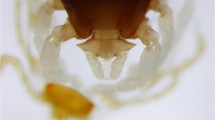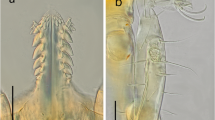Abstract
Rhipicephalus turanicus is a three-host tick that lives in lowland desert and semi-desert, steppe and open woodlands (Filippova 1997). This species is under discussion due to the morphological, biological and molecular variability of ticks identified as R. turanicus in different countries. For this reason, many records in the literature are currently considered speculative pending confirmation (Guglielmone et al. 2014). Indeed, genetic data indicate that ticks identified as R. turanicus in some regions (e.g. in some African countries) may actually represent different species (Beati and Keirans 2001; Dantas-Torres et al. 2013a). This species feeds on mammals (e.g. rodents, lagomorphs, canids, felids and mustelids), birds and lizards (Filippova 1997; Dantas-Torres et al. 2011, 2013a). Larvae and nymphs have also been found on birds, while the adult stage also occurs on lizards (Filippova 1997). Human infestation has been reported (Filippova 1997).
Access provided by CONRICYT-eBooks. Download chapter PDF
Similar content being viewed by others
Life Cycle and Host Preferences
Rhipicephalus turanicus is a three-host tick that lives in lowland desert and semi-desert, steppe and open woodlands (Filippova 1997). This species is under discussion due to the morphological, biological and molecular variability of ticks identified as R. turanicus in different countries. For this reason, many records in the literature are currently considered speculative pending confirmation (Guglielmone et al. 2014). Indeed, genetic data indicate that ticks identified as R. turanicus in some regions (e.g. in some African countries) may actually represent different species (Beati and Keirans 2001; Dantas-Torres et al. 2013a). This species feeds on mammals (e.g. rodents, lagomorphs, canids, felids and mustelids), birds and lizards (Filippova 1997; Dantas-Torres et al. 2011, 2013a). Larvae and nymphs have also been found on birds, while the adult stage also occurs on lizards (Filippova 1997). Human infestation has been reported (Filippova 1997).
Ecology
Adults of R. turanicus have been found questing during the spring and summer months. In southern Italy, this species is mostly found in grasslands and meadow habitats (Dantas-Torres et al. 2013b). In the same area, two males and a nymph of R. turanicus were found on Corsican hares in early autumn (Dantas-Torres et al. 2011). Considering the uncertainties about the identity of ticks identified as R. turanicus, data on the ecology of this tick is uncertain.
Distribution
Rhipicephalus turanicus is a Palaearctic species whose precise geographical distribution is unknown, considering that many distribution records are currently speculative (Filippova 1997; Dantas-Torres et al. 2013a; Guglielmone et al. 2014). It is heavily suspected that what has been classically described as ‘R. turanicus’ in Europe west to Turkey might, in fact, represent another entity. It is important to notice that molecular sequences available in GenBank are expected to have the same degree of unreliability as mentioned for the records or the knowledge of the ecology of this species. There are currently only two valid sequences of R. turanicus in GenBank, acknowledged as coming from this species from specimens determined by N.A. Filippova.
Vectorial Capacity and Pathogen Burden
Since the taxonomic status of R. turanicus is under discussion, its role as a vector of human pathogens, including Rickettsia massiliae, R. conorii and other microorganisms molecularly detected in ticks designated as this species, needs confirmation. The reliability of tick identification in some old studies on the vector role of R. turanicus for different pathogens may be argued. Further studies are needed to determine its participation in transmission.
A–G The male of R. turanicus. A Dorsal, B ventral, C capitulum, dorsal, D capitulum, ventral, E spiracular plate, F hypostome, G coxae and trochanters I–IV. H–N The female of R. turanicus. H Dorsal, I ventral, J capitulum, dorsal, K capitulum, ventral, L spiracular plate, M hypostome, N coxae and trochanters I–IV. Illustrations redrawn from Filippova (1997)
A–G The nymph of R. turanicus. A Dorsal, B ventral, C capitulum, dorsal, D capitulum, ventral, E spiracular plate, F hypostome, G coxae and trochanters I–IV. H–M The larva of R. turanicus. H Dorsal, I ventral, J capitulum, dorsal, K capitulum, ventral, L hypostome, M coxae and trochanters I–III. Illustrations redrawn from Filippova (1997)
References
Achutan HN, Mahadevan S, Lalitha M (1980) Studies on the developmental forms of Babesia bigemina and Babesia canis in ixodid ticks. Indian Vet J 57:181–184
Balashov YS, Daiter AB (1973) Bloodsucking arthropods and rickettsiae. Nauka, Leningrad (in Russian)
Beati L, Keirans JE (2001) Analysis of the systematic relationships among ticks of the genera Rhipicephalus and Boophilus (Acari: Ixodidae) based on mitochondrial 12S ribosomal DNA gene sequences and morphological characters. J Parasitol 87:32–48
Berdyev A (1980) Ecology of ixodid ticks of Turkmenistan and their importance in epizootiology of natural-foci diseases. Ylym, Ashkhabad, Turkmenistan (in Russian)
Dantas-Torres F, Testini G, DiGeronimo PM, Lorusso V, Mallia E, Otranto D (2011) Ticks infesting the endangered Italian hare (Lepus corsicanus) and their habitat in an ecological park in southern Italy. Exp Appl Acarol 53:95–102
Dantas-Torres F, Latrofa MS, Annoscia G, Giannelli A, Parisi A, Otranto D (2013a) Morphological and genetic diversity of Rhipicephalus sanguineus sensu lato from the new and old worlds. Parasit Vectors 6:213
Dantas-Torres F, Lia RP, Capelli G, Otranto D (2013b) Efficiency of flagging and dragging for tick collection. Exp Appl Acarol 61:119–127
Filippova NA (1997) Ixodid ticks of subfamily Amblyomminae. In the fauna of Russia and neighboring countries. New Series no. 145: Arachnoidea, vol 4(5), St. Petersburg, Nauka (in Russian)
Guglielmone AA, Robbins RG, Apanaskevich DA, Petney TN, Estrada-Peña A, Horak IG (2014) The hard ticks of the world (Acari: Ixodida: Ixodidae). Springer, Dordrecht, p 738
Keysary A, Massung RF, Inbar M, Wallach AD, Shanas U, Mumcuoglu KY, Waner T (2007) Molecular evidence for Anaplasma phagocytophilum in Israel. Emerg Infect Dis 13:1411–1412
Mitchell CJ, Spillett JJ (1968) Ecological notes on Rhipicephalus turanicus Pomerantzev in West Bengal, India (Acarina: Ixodidae). J Med Entomol 5:5–8
Walker JB, Keirans JE, Horak IG (2000) Genus Rhipicephalus (Acari, Ixodidae). A guide to the brown ticks of the world. Cambridge University Press, Cambridge
Author information
Authors and Affiliations
Corresponding author
Editor information
Editors and Affiliations
Rights and permissions
Copyright information
© 2017 Springer International Publishing AG, part of Springer Nature
About this chapter
Cite this chapter
Dantas-Torres, F., Otranto, D., Santos-Silva, M.M., Vatansever, Z. (2017). Rhipicephalus turanicus Pomerantzev, 1940 (Figs. 130–132). In: Estrada-Peña, A., Mihalca, A., Petney, T. (eds) Ticks of Europe and North Africa. Springer, Cham. https://doi.org/10.1007/978-3-319-63760-0_63
Download citation
DOI: https://doi.org/10.1007/978-3-319-63760-0_63
Published:
Publisher Name: Springer, Cham
Print ISBN: 978-3-319-63759-4
Online ISBN: 978-3-319-63760-0
eBook Packages: Biomedical and Life SciencesBiomedical and Life Sciences (R0)







